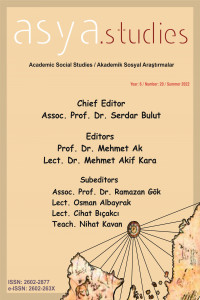Öz
The traditional Indian music system is still sophisticated one. This music consisted of the melodies, micro-intervals and complex rhythmic is a very valuable contribution to the world culture. Since it is impossible to convey the subtle sounds and countless rhythms of unprecedented Indian music in written form, compositions have been transmitted by “oral play” method. However, this does not mean that Indian music has never been recorded throughout history. In fact, the history of notations in India is rooted in the distant past. Notation systems, which have emerged from time to time to keep music and prevent loss, also provide access to older compositions. In this article, in which we will discuss the musical notation system of India, which has played a very important role in the cultural shaping of world music history, we want to give some information on this subject.
Anahtar Kelimeler
Notating Indian Music Swaralipi Sargam Guru-Shishya Tradition Paluskar and Bhatkhande Notation System
Kaynakça
- Alison, A. (Ed).; Nettl, B.; Ruth M.; James, P. ve Rice T. (2000). South Asia the Indian Subcontinent. The Garland Encyclopedia of World Music. United Kingdom: Taylor & Francis.
- Divekar, H. ve Tribhuwan, R. (2001). Rudra Veena: An Ancient String Musical Instrument. New Delhi: Discovery Publishing House.
- Eismont, P. ve Konstantinova, N. (2015). Language, Music, & Computing. First International Workshop, LMAC 2015. April 20-22. Revised Selected Papers, St. Petersburg. Russia: Springer Publication.
- Kumar, R. (2003). Essays on Indian Music. New Delhi: Discovery Publishing House.
- Manoharan, P. (2008). Towards Fusion: New Trends in Hindustani Sitar Music in Malaysia. Wacana Seni Journal of Arts Discours, 0(7), 24-25.
- Misra, C.; Chakraborty, T.; Anupam, B. ve Bhattacharya B. (2016). Swaralipi: A Framework for Transcribing & Rendering Indic Music Sheet, Second International Conference on Technology for Music Notation & Representation, Union of International Associations, Brussels, Belgium.
- Morozova, Т. (2004) Indiyskaya Notopis i Spesifika eye Primeneniya k Traditsionnym Muzykalnym Formam. Iskusstvo Vostoka. Khudozhestvennaya Forma i Traditsiya. St. Petersburg. Russia.
- Morozova, Т. (2006). Notopisnoe Naslediye Indii. Znakovaya Svyazi Vremen. Russia: IKAR.
- Morris, R. (2011). Tana Varnam-S: An Entry into Rāga Delineation in Carnatic Music. Analytical Approaches to World Music, 1(1), 1-27.
- Nayar, S. (1989). Bhatkhande's Contribution to Music: A Historical Perspective. India: Popular Prakashan Pub.
- Norman, K. (1979). Sāmavedic Chant by Wayne Howard (Book Review). Modern Asian Studies, 13(3), 524; Wayne Howard (1977), Samavedic Chant, Yale University Press.
- Ramakrishna, L. (2003). Musical Heritage of India. India: Shubhi Publication.
- Thakur, P. (2010). Indian Music Masters of Our Times. India: Pradeep Thakur & Sons Pub.
- Vedabala, S. (2021). Sitar Music: The Dynamics of Structure and its Playing Techniques. New Delhi. India: Wizard Publisher.
- Zon, B. (2017). Music & Orientalism in the British Empire, 1780s-1940s: Portrayal of the East. United Kingdom: Routledge.
- https://chandrakantha.com/music-and-dance/i-class-music/n-indian-notation/ adresinden 22.10.2021 tarihinde erişildi.
Öz
Geleneksel Hint müziği bu zamana kadar var olan en sofistik müzik sistemlerinden birine sahiptir. Benzersiz melodiler, mikro aralıklar ve karmaşık ritimlerden oluşan Hint müziği dünya kültürüne oldukça değerli bir katkı sağlamıştır. Sıradışı Hint müziğine özgü incelikli seslerin ve sayısız ritimlerin yazıyla gösterilmesi pek mümkün olmadığından, yüzyıllar boyunca öğretim yönteminde besteler “ağızla çalarak” aktarılmıştır. Lakin bu, Hint müziğinin tarih boyunca hiç notaya alınmadığı anlamına da gelmez. Oysa Hindistan’da notasyonun geçmişi oldukça gerilere gitmektedir. Müziğin saklanması ve kaybolmasını önlemek amacıyla zaman zaman ortaya çıkan notalama sistemleri, aynı zamanda eski bestelere ulaşabilme imkânını sağlamıştır. Dünya müzik tarihinin kültürel oluşumunda çok önemli bir paya sahip Hindistan’ın notasyon sistemlerinin ele alındığı bu makalede konuya ilişkin birtakım bilgiler vermek hedeflenmiştir.
Anahtar Kelimeler
Hint Müziğinde Notalama Swaralipi Sargam Guru-Shishya Geleneği Paluskar ve Bhatkhande Notasyon Sistemi
Kaynakça
- Alison, A. (Ed).; Nettl, B.; Ruth M.; James, P. ve Rice T. (2000). South Asia the Indian Subcontinent. The Garland Encyclopedia of World Music. United Kingdom: Taylor & Francis.
- Divekar, H. ve Tribhuwan, R. (2001). Rudra Veena: An Ancient String Musical Instrument. New Delhi: Discovery Publishing House.
- Eismont, P. ve Konstantinova, N. (2015). Language, Music, & Computing. First International Workshop, LMAC 2015. April 20-22. Revised Selected Papers, St. Petersburg. Russia: Springer Publication.
- Kumar, R. (2003). Essays on Indian Music. New Delhi: Discovery Publishing House.
- Manoharan, P. (2008). Towards Fusion: New Trends in Hindustani Sitar Music in Malaysia. Wacana Seni Journal of Arts Discours, 0(7), 24-25.
- Misra, C.; Chakraborty, T.; Anupam, B. ve Bhattacharya B. (2016). Swaralipi: A Framework for Transcribing & Rendering Indic Music Sheet, Second International Conference on Technology for Music Notation & Representation, Union of International Associations, Brussels, Belgium.
- Morozova, Т. (2004) Indiyskaya Notopis i Spesifika eye Primeneniya k Traditsionnym Muzykalnym Formam. Iskusstvo Vostoka. Khudozhestvennaya Forma i Traditsiya. St. Petersburg. Russia.
- Morozova, Т. (2006). Notopisnoe Naslediye Indii. Znakovaya Svyazi Vremen. Russia: IKAR.
- Morris, R. (2011). Tana Varnam-S: An Entry into Rāga Delineation in Carnatic Music. Analytical Approaches to World Music, 1(1), 1-27.
- Nayar, S. (1989). Bhatkhande's Contribution to Music: A Historical Perspective. India: Popular Prakashan Pub.
- Norman, K. (1979). Sāmavedic Chant by Wayne Howard (Book Review). Modern Asian Studies, 13(3), 524; Wayne Howard (1977), Samavedic Chant, Yale University Press.
- Ramakrishna, L. (2003). Musical Heritage of India. India: Shubhi Publication.
- Thakur, P. (2010). Indian Music Masters of Our Times. India: Pradeep Thakur & Sons Pub.
- Vedabala, S. (2021). Sitar Music: The Dynamics of Structure and its Playing Techniques. New Delhi. India: Wizard Publisher.
- Zon, B. (2017). Music & Orientalism in the British Empire, 1780s-1940s: Portrayal of the East. United Kingdom: Routledge.
- https://chandrakantha.com/music-and-dance/i-class-music/n-indian-notation/ adresinden 22.10.2021 tarihinde erişildi.
Ayrıntılar
| Birincil Dil | Türkçe |
|---|---|
| Bölüm | Araştırma Makaleleri |
| Yazarlar | |
| Yayımlanma Tarihi | 30 Haziran 2022 |
| Gönderilme Tarihi | 25 Ocak 2022 |
| Yayımlandığı Sayı | Yıl 2022 Cilt: 6 Sayı: 20 |


